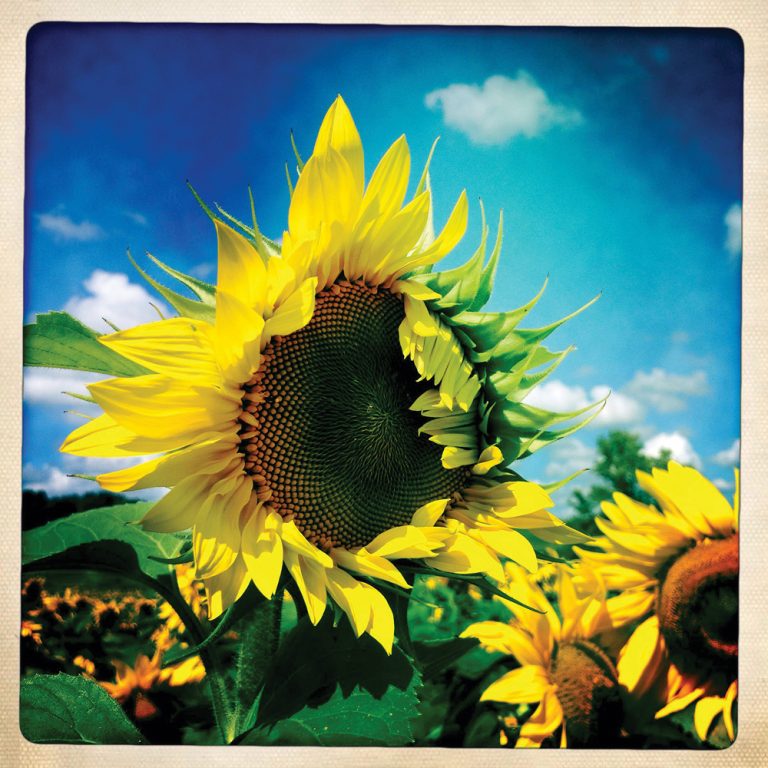We have a simple wooden Buddha figure on our home altar. During a surfing holiday in Bali, our son Jesse purchased this Buddha from a seaside craftsman. Jesse asked forgiveness of the Buddha before wrapping him in old T-shirts and a salty towel and hauling the World- Honored One home to the Left Coast of northern California.
This morning as autumn ravages the garden, our Balinese Buddha is dusted with thick drifts of gold sunflower pollen. Above him in a vase the last Hopi Black Dye sunflowers of the season silently expire. “Ah! sunflower,” whispers William Blake, “weary of time.”
The original Pomo and Coast Miwok people of the Bay Area teach that time is always told in linked events. The garden work of late October is measured by the rhythm of the noble sunflower harvest. As altar flowers shed their last pollen we rig wire scaffolding in our warm living room to dry hundreds of seed heads of Hopi sunflowers for next year’s planting.
I love to study the faces of these darkeyed beauties. Each sunflower seed head is composed of between one and four thousand individual flowers growing in a densely curved pattern of intersecting spirals. Thirty-four spirals spin clockwise from the center of a single flower to merge with another whorl of fifty-five spirals turning in a counterclockwise gyre—a dizzying fractal sequence of tightly joined spirals that allows the maximum number of seeds to ripen on the face of each sunflower.
I always leave a few Hopi sunflowers in the garden at year’s end to feed the hungry birds of autumn. Purple finches peck out spiral seed sockets of the last flowers, feasting on indigo wisdom from the ancient Hopi world.
I remember receiving the seed of these Black Dye sunflowers more than thirty years ago. An old Zen friend passed them to me, warm hand to warm hand, upon her return from a pilgrimage to the Third Hopi Mesa in Arizona, one of the oldest continuously inhabited dwelling places in North America.
We planted the sunflowers in a rough spiral in the early farm fields of Green Gulch. In the 1990s, Gary Paul Nabhan, author, ethnobotanist, and cofounder of the conservation organization Native Seeds/SEARCH, visited us there. I remember his genuine delight upon discovering Southwestern pueblo sunflowers growing vigorously in the long foggy outbreath of the Pacific Ocean.
The culture of sunflowers is vast beyond measure. Native Americans in the eastern United States first began to domesticate these plants more than three thousand years before the Common Era. Throughout the indigenous world, sunflowers are considered kin and treated with reverence and respect. They provide food, medicine, oil, shelter, fiber, and ceremonial support. All parts of the plant are cherished and used to support the life cycle of their people. In the iconic Hopi pueblo tradition midnight blue dye is extracted from the cracked open hulls of each sunflower.
During his visit to Green Gulch Farm, Nabham taught us about a rare member of the sunflower tribe, Helianthus anomalus. The anomalus sunflower is a deviant relative of the domesticated Hopi Black Dye plant. Whenever this weedy ancestor germinates on Hopi farmland, it is honored and protected as a revered elder. The Hopi people count the wild sunflower as blood kin. The anomalous sunflower carries an irregular genetic code that helps to strengthen the cultivated field. A scrappy outlier, it provides resistance to rots and wilts and protects domesticated sunflower family members from the harmful effects of drought, withering heat, and pestilence.
The range of the anomalous sunflower is not limited to the lowland fields of the Hopi Nation. This ancestral plant also grows at the edge of the high mesa ceremonial kiva (underground chamber). There, its long gold petals are gathered by Hopi maidens every autumn to prepare a celebratory powder for use in the sacred dances of the season. The anomalous sunflower petals are dried and pounded into a paste. Each maiden rubs the paste into the moistened skin of her face until her very countenance radiates with the living gold of her sunflower ancestors.
One of my favorite poems, “Sunflower,” by the Norwegian poet Rolf Jacobson, begins with a double question:
What sower walked over earth,
Which hands sowed
Our inward seeds of fire?
I trust that the perennial relationship between the Hopi people and their weedy sunflower ancestor is not an anomaly. Rather than being simply a deviation from the norm, the kinship demonstrated here of the human and more-than human world generates a common ecology of the heart. In times of climate disruption and species extinction a family circle of sowers and seed move across the earth. Inward seeds of fire are sown to warm and nourish all beings in the ten directions.
Thank you for subscribing to Tricycle! As a nonprofit, we depend on readers like you to keep Buddhist teachings and practices widely available.
